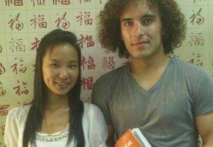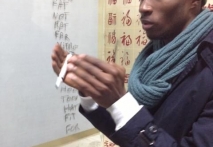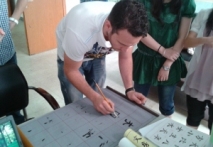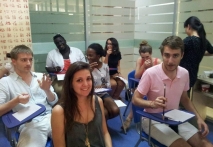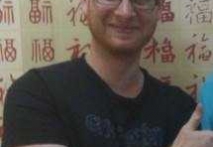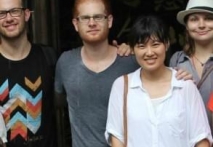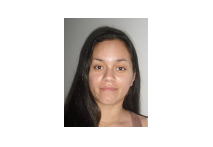Latest News
- Wuxi's Nanchang Street--a historic cultural district that combines classical charm, delicious food, and fun activities
- chinese study
- lastest courses
- Business Assistance/International Consortium of Stem Cell Research
- Foreigner's view of Jiangsu -Changzhou Jintan starts
- estimonials for Our new French Internship student Anais 企业表扬信
- The Double Seventh Festival in China Introduction
- Chinese Proficiency Test (HSK)
- China University Mining and Technology
- Wuxi Library
Students Say
Mandarin Student Zack
Mandarin Education School is a great place to learn Chinese and Chinese Culture.I've learned a lot in this school, my Chine...
Learn Chinese Travel China
If you want to learn Chinese and also discover China, Mandarin Education organize the most funny and cultural study tour.
The...
suzhou Mandarin Jude
I am Jude, I am learning Mandarin in Suzhou Mandarin School,I was learning in Wuxi Mandarin Education too.I like my Chinse Teacher...
chinese class
Improve your reading, speaking and your writing by experiencing our teaching methods,Offer free student Visa.
...
Wuxi Mandarin Jessie
I've learned Chinese for almost 8 years, I can understand what Chinese people say,but when I speak, I feel very uncomfor...
Chinese Internship or Jobs
You are looking for a professional experience abroad? Get the opportunity to discover the Chinese business,Look for an ...
Mandarinedu Student Florent
I love my Wuxi Mandarin Education School. It is the EASY MANDARIN Learning way, I am learning faster than I wanted.My teach...
Mandarin E Learning
Mandarin Education School offers you Online Chinese Courses. It has never been so easier to have Chinese courses ...
Mandarin Student Brad
I am studying Chinese in Mandarin Education School. I can speak quit good Chinese and talk to Chinese people by myself. Thank...
Wuxi Mandarin edu. Student Jennifer
I love learning Chinese in Mandarin Education School.That's a great place to learn and make friends.
...
Add Our School Official
to get more informations

0086 1866 1199 988
0086 510-81151808
Sandy.Swun
519988808
Mandarin Education School
Room 405, 4 Fl,Building No.8,
Maoye Business Center,
Chang jiang No.1,
New district , Wuxi City , China
的、地、得用法分析:
“的”后面跟的都是表示事物名称的词或词语,如敬爱的总理、慈祥的老人、戴帽子的男孩、…
“地”后面跟的都是表示动作的词或词语,如:高声地喊、愉快地唱、拼命地逃、疯狂地咒骂、…
“得”前面多数是表示动作的词或词语,少是形容词;后面跟的都是形容事物状态的词或词语,表示怎么怎么样的,如:走得很快、踩得稀烂、疼得直叫唤、瘦得皮包骨头、红得发紫、气得…
的、地、得用法总结
1、“的”前面的词语一般用来修饰、限制“的”后面的事物,说明“的”后面的事物怎么样。结构形式一般为:修饰、限制的词语+的+名词。
2“地”前面的词语一般用来形容“地”后面的动作,说明“地”后面的动作怎么样。结构方式一般为:修饰、限制的词语+地+动词。
3“得”后面的词语一般用来补充说“得”前面的动作怎么样,结构形式一般为:动词(形容词)
+得+补充、说明的词语。
的、地、得用法例句:
1、蔚蓝色的海洋,波涛汹涌,无边无际。
2、向日葵在微风中向我们轻轻地点头微笑。
3、小明在海安儿童玩得很开心。
The analysis of the usage of "De", "De" and "Availability":
"De" is followed by words or phrases expressing the name of things, such as the beloved Prime Minister, the kind old man, the boy wearing a hat, the ___________
"De" is followed by words or words expressing actions, such as shouting loudly, singing happily, running away desperately, swearing madly, cursing wildly, and ___________.
"De" is usually preceded by words or adjectives expressing actions, but seldom by adjectives; followed by words or words describing the state of things, indicating how to do, such as: walking fast, trampling sparsely, crying in pain, skinny, red, purple, angry.
A Summary of the Uses of De,De,De
1. The words in front of "de" are generally used to modify and restrict the things behind "de" to show how things behind "de" are. The structural form is generally: modifier and restrictive words + de + noun.
2. The words in front of "de" are generally used to describe the actions behind "de" and to show how the actions behind "de" are. Generally speaking, the structure is: modifying and restricting words + ground + verbs.
3. The words after "de" are usually used to supplement the actions before "de". The structure is usually verb (adjective).
+ "De + Supplementary" and "Explanatory" words.
De, De and de Sentences: De, De and de Sentences:
1. The blue ocean is rough and boundless.
2. Sunflower nods and smiles gently to us in the breeze.
3. Xiao Ming had a good time with Haian children.
的、地、得의 사용법 분석하다
1.“的”의 뒤에 따라는 것 다 사물의 명칭을 나타내는 글자나 단어들이다. 예를들면:
敬爱的总理경애하는 총리,慈祥的老人자상한 노인,戴帽子的男孩모자를 쓴 소년.......
2.“地”의 뒤에 따라는 것 다 동작을 표시하는 글자나 단어이다.예를들면:(高声地喊)큰 소리로 외치다,(拼命地逃)필사적으로 도망치다,(疯狂地咒骂)미친 듯이 악담을 퍼붓다......
3.“得”의 앞에 대부분은 동작을 표시하는 글자나 단어이고 소수부분은 형용사이다.뒤에 따라는 것 다 사물의 상태를 형용하는 글자나 단어이고 어떻게 된 지를 나타내다.예를들면:走得很快매우 빨리 걷다, 踩得稀烂밟아서 산산이 부서지다, 疼得直叫唤아파서 줄곧 소리지르다, 瘦得皮包骨头여위어 피골이 상접하다, 红得发紫인기가 대단하다…
的、地、得의 사용법 총화하다
1. “的”앞의 단어는 일반적으로 “的”뒤에 있는 것을 수식하고 제한한다.“的”뒤의 사물이 어떤지를 설명하다.
구조형식은 일반적으로 다음과 같다:수식/제한하는 단어+的+명사
2. “地”앞의 단어는 일반적으로 “地”뒤에 있는 동작을 형용하다.“地”뒤의 동작이 어떤지를 설명하다.
구조형식은 일반적으로 다음과 같다:수식/제한하는 단어+地+동사
3. “得”뒤의 단어는 일반적으로 “得”앞의 동작이 어떤지 보충 설명하다.
구조형식은 일반적으로 다음과 같다:동사(형용사)+得+보충하고 설명하는 단어
的、地、得의 사용법 예문
1、蔚蓝色的海洋,波涛汹涌,无边无际。
푸른 바다와 파도가 용솟음치며 가없이 넓다.
2、向日葵在微风中向我们轻轻地点头微笑。
해바라기가 미풍속에서 우리에게 가볍게 고개를 끄덕이며 미소를 짓는다.
3、小明在海安儿童玩得很开心。
소명은 해안아동락원에서 아주 즐겁게 놀았다.
